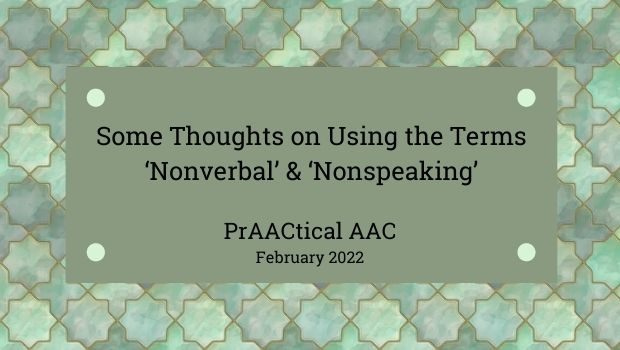Some Thoughts on Using the Terms ‘Nonverbal’ and ‘Nonspeaking’

Terminology has always been a challenge in the field of AAC, at least in English. Why does it take 14 syllables (“aug-men-ta-tive and al-ter-na-tive com-mu-ni-ca-tion”) to refer to a field that emerged to support individuals for whom speech is intensely problematic?
I remember spirited discussions on what to call this work back when I was at Purdue University on an AAC doctoral fellowship, just after the birth of the International AAC Society (ISAAC) in 1983. When the US Society for AAC was started in 1991, those debates continued.
The terms ‘nonvocal,’ ‘nonoral,’ ‘nonspeech,’ and ‘nonspeaking’ were used by many in the early days. Those terms eventually dwindled in popularity, primarily because so many children and adults who needed the support of AAC were able to talk and/or make sounds. Often, their speech was difficult to understand, slow and exhausting to produce, and limited in terms of conventional structures for expressing themselves in sentences and longer narratives. Still, it was effective in some contexts and their preferred means of expression. The majority of people who came to our clinics or were in our classrooms were able to make sounds orally and had some spoken language, so describing them in these ways didn’t really fit. Those who were literate and able to share precise and nuanced thoughts about these terms, sometimes expressed displeasure with our choices in terminology.
‘Nonverbal’ was another early term used in AAC, but it, too, is flawed. In English, the word ‘verbal’ is generally used to mean ‘relating to or in the form of words’ (Oxford Languages). Since words can be expressed not only with speech but also with writing, signs, pictures, and even objects, this term has some appeal.
Depending on the context, nonverbal still seems to be an appropriate descriptor. Consider these two examples from clinical report-writing.
- Lakeisha communicates in a variety of ways. Her verbal communication modalities include the use of word approximations (e.g., “Duh-duh” for “Dora;” “Guh-wuh” for “go away”), keyword signing, conventional gestures (e.g., patting the chair to indicate ‘come sit with me”), and Picture Communication Symbols (PCS). Nonverbally, she communicates through things like body movement (e.g., turning her head, moving away to reject/protest), vocalizations (e.g., “eee’ for requesting attention), and eye pointing (e.g., staring at something she wants).
- Because Yusef is primarily a nonverbal communicator, it is imperative that his educational team be trained to watch for his communicative signals, acknowledge them, and respond to his intent. Otherwise, his communicative attempts are likely to go unrecognized, which will negatively impact his growth, development, and well-being.
In these situations, the use of ‘nonverbal’ refers to communication without the use of language/words and not merely a lack of speech. We all use nonverbal communication, and it is not inherently inferior to verbal communication. In some contexts, it’s the most effective means of expression. For example, if you asked me where the door is, I’d probably point to it rather than saying “It’s 110% over my left shoulder.” Verbal doesn’t always mean better.
Context is everything in using terms appropriately. All forms of communication are valid, should be honored, and supported in ways that address the individual’s values and priorities.
Do you struggle with the terminology used in the AAC field or have ideas on how to address this? We’d love to hear your perspective.
::::::::::::::::::::::::::::::::::::::::::::::::::::::::::::::::::::::::::::::::::::::::::::::::::::::::::::::::::::::::
Filed under: Featured Posts, PrAACtical Thinking
This post was written by Carole Zangari
